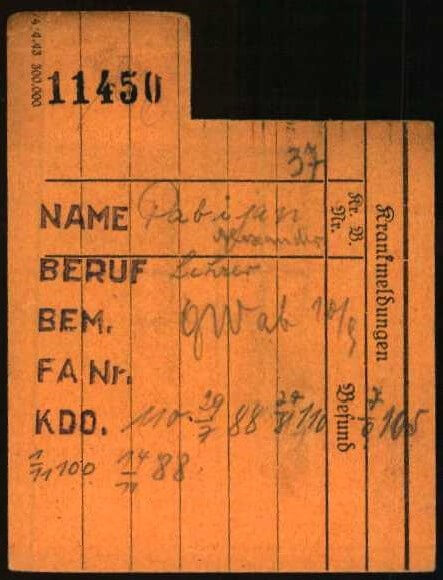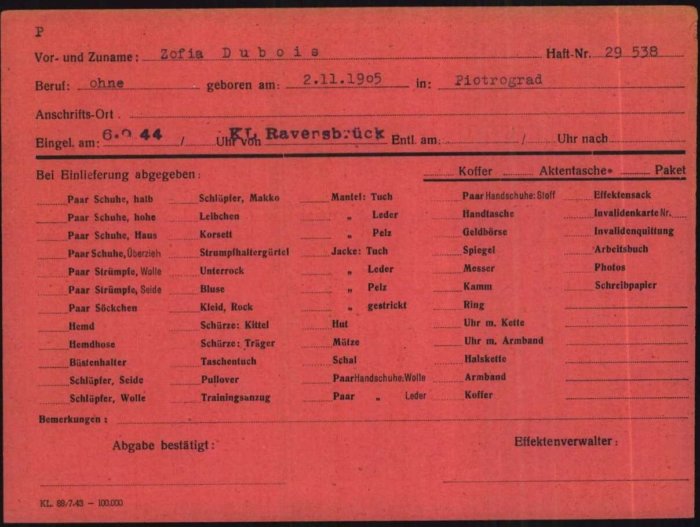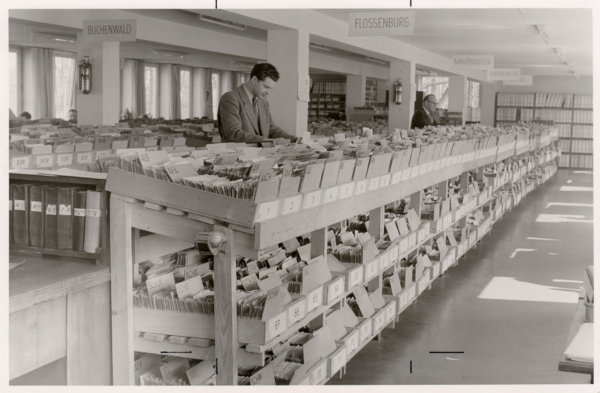Incarceration
and
Persecution

Incarceration documents are originals and reproductions of documents that were produced by the Nazis for managing deportees. Today they help document fates and make it possible to trace individual paths of persecution. They strikingly illustrate the scale of the abductions and deportations carried out by the Nazi regime.
The collection is divided into two parts: documents from the concentration camp system, and documents from police persecution authorities such as the Gestapo. Documents that relate directly to a specific concentration camp, transit camp, labor camp or ghetto and were used for camp administration are found in the first part of the collection. For instance, prisoners who were taken to Buchenwald concentration camp from other camps were meticulously registered with their name, prisoner number, reason for imprisonment and the date they arrived in Buchenwald. Documents such as these were used to organize the prisoners in Buchenwald, and similar documents exist for other camps as well.
Insights into the reality of the camps
The second part of the collection consists of persecution documents from the Gestapo, prisons and other organizations. These incarceration documents make up one of the largest document groups in the Arolsen Archives. In many cases, they make it possible to reconstruct paths of persecution and provide critical insights into the reality of the camps. For example, the collection includes records pertaining to the administration of the clothing and personal items (known as effects) that the prisoners brought to the camp, their labor assignments, punishments in the camp, medical treatment and, finally, their death or survival.


Labor assignment cards, like shown on the left, were used in the Buchenwald concentration camp to document in which labor or sub-camp prisoners were forced to work. Effect cards (see below) were used to administrate personal belongings that prisoners had to yield when they arrived in the concentration camp.
How was the collection created?
At the end of the war, the administrative documents found in the concentration camps were centrally collected by the International Refugee Organization (IRO). As a tracing office and point of contact for relatives of Nazi victims, the IRO wanted to be able to supply information about former prisoners. The documents are therefore arranged by camp type – i.e., transit camp, labor camp, concentration camp – and by region. Another group of documents relates to ghettos. The records are further subdivided into general documents (such as correspondence about a camp or ghetto), list material and individual documents. The documents are chronologically sorted within these sub-groups.

Historical picture of an employee in the former archive of the Arolsen Archives.
Individual documents relate to individual people and were created for administrative purposes by the camp personnel when a person was imprisoned. The individual documents include Prisoner Registration Cards, labor assignment cards and questionnaires. List material makes up another large and very informative collection. These documents show which prisoners were transported to which labor or sub-camp on which date. The list material includes arrival, transport and death lists as well as reports of escapees.
A fate in documents: Chaja Bengen
The persecution of Chaja Bengen, a Jewish woman from Poland, began when she was arrested by the security police at the age of 19. Documents from Buchenwald show that Chaja was first interned in the Riga ghetto. The ghetto was dissolved a year later and the security police took the internees to the Stutthof concentration camp. Chaja was among the last to leave the ghetto alive. One month later, her name was recorded on a transfer list for a transport of 300 female prisoners being sent to the “Arbeitskommando” Magdeburg, a sub-camp of Buchenwald. Chaja was forced to work as a seamstress there.

Prisoner Registration Cards, which were created in all main concentration camps for the prisoners, were used to list the most important biographical data of a person.

This questionnaire was used to asses all new prisoners in the concentration camps.

On these number cards for the female prisoners in the Buchenwald concentration camp subcamps, the Nazis indicated, on the one hand, various subcamps. In addition, some cards indicated transfers to other camps.
When reading and interpreting these documents, it is critical to remember that they were produced by Nazi perpetrators and institutions involved in deportation, exploitation and murder. They are filled with stereotypical attributions geared toward the logic of persecution. Many of the details in them are downplayed and must be read in the context in which they were produced. Our e-Guide will help you better understand the documents’ structure, use and historical context.

